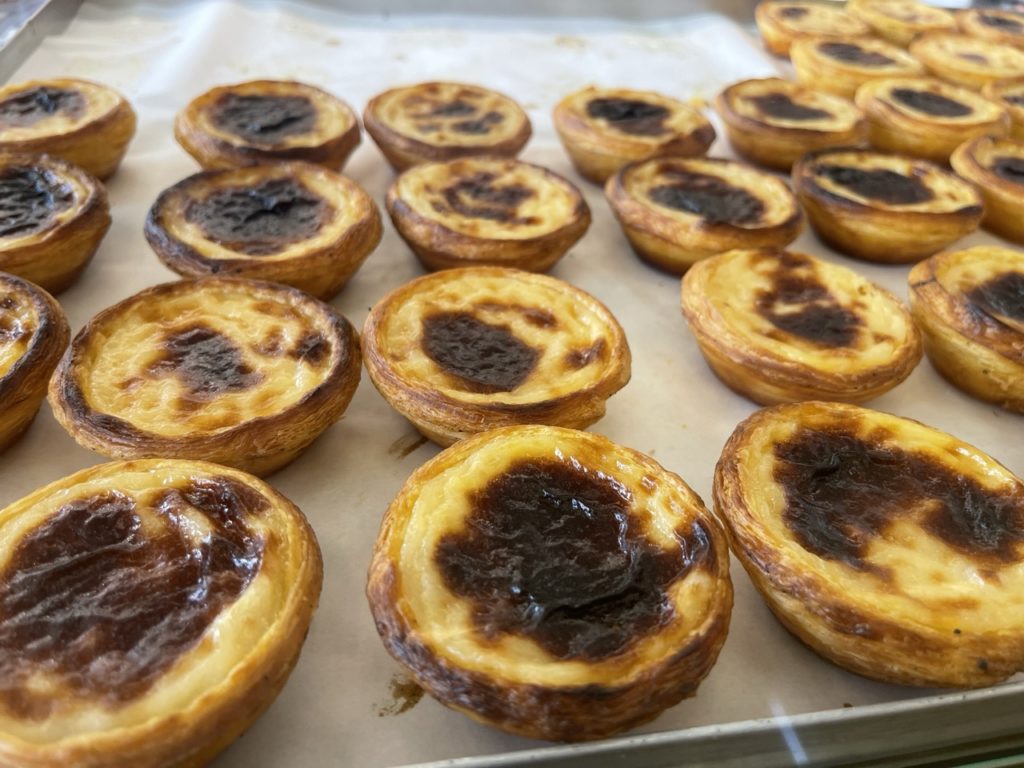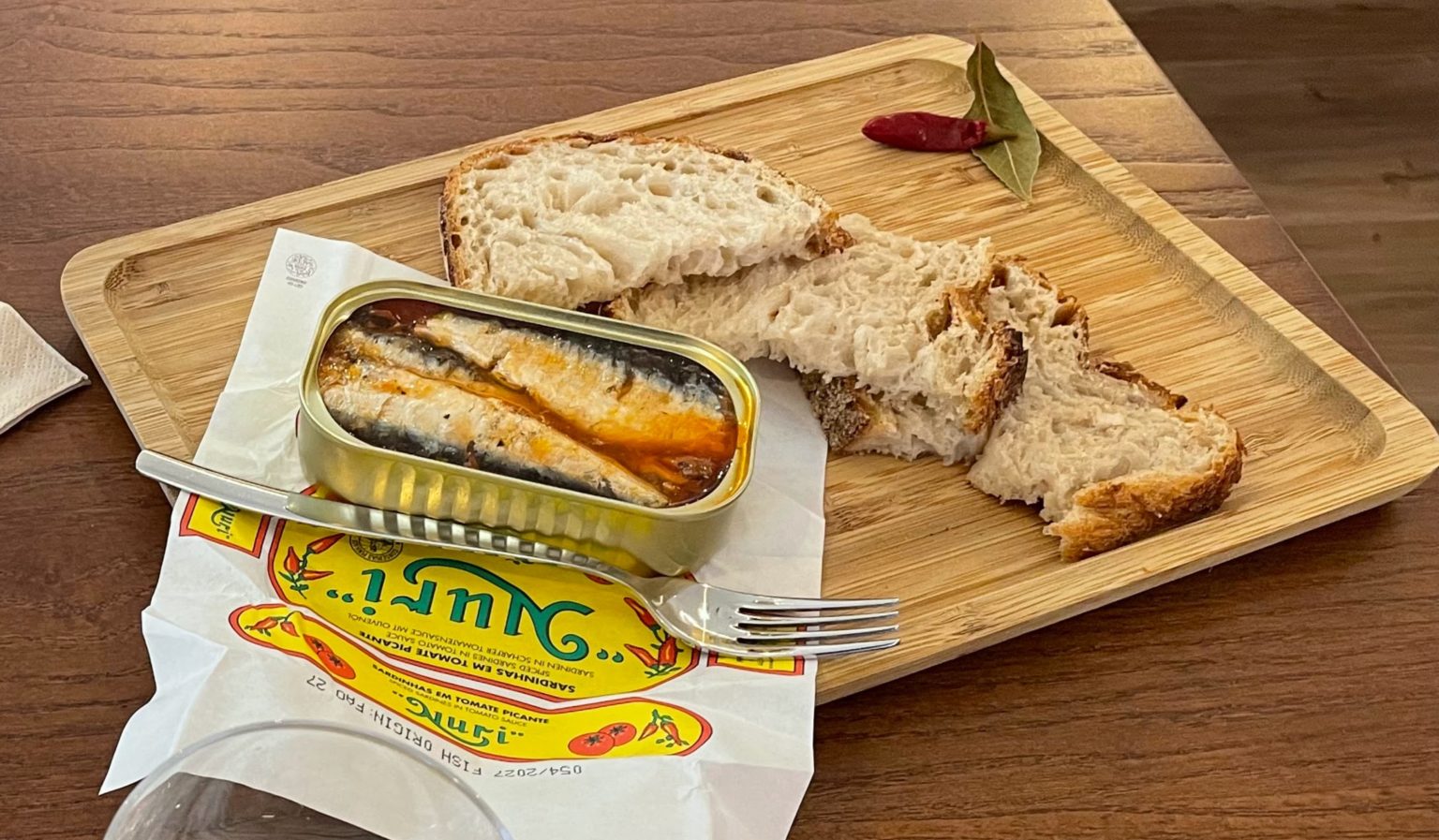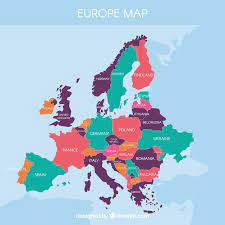Here’s the previously promised (and long awaited?) chapter on our foodie adventures in Lisbon and Porto. We hope you enjoy it. Bom Apetite!
BACALHAU
The story of Portuguese culinary traditions must begin with Codfish (Bacalhau). Cod is a big deal in Portugal. It is called “fiel amigo” (faithful friend) and I’ve read that every Portuguese restaurant has at least one dish made of codfish. (I can attest to this based on my limited sample size.) I’ve also read that 20% of all cod caught around the globe are eaten in Portugal – an average of 35 kilograms (77 pounds) per person, per year. That’s about 1 ½ pounds of cod every week!
What the Portuguese call “bacalhau” is North Atlantic cod that has been salted and dried. 95% of the 77 pounds per person referenced above is in this form – salted and dried. Fresh cod is a relatively new thing in Portugal. Seems crazy, right? Here’s the story…
• There are no cod off the Portuguese coast. All the codfish eaten in Portugal is caught in the cold waters off Norway, Newfoundland, Iceland, etc.
• Portuguese have been fishing cod off the coast of Newfoundland since the sixteenth century during the Age of Discoveries.
• To preserve the cod for the long trip home, salt was used. By the time it arrived in Lisbon, it was salted, dried, plentiful, and cheap – known as “the meat of the poor.”
• The resulting bacalhau is so well preserved by the salting and drying that it will literally keep for years, making it the perfect food stuff for long sea voyages. Remember that “age of discovery” stuff? It turns out dried cod played a key role.
• To prepare it for cooking, it’s sliced into filets, washed, covered with water and/or milk and kept in the refrigerator for 2-3 days (changing the liquid every 6 hours). This soaking and rinsing re-hydrates the fish and rinses out most of the salt.
• Finally, we’re ready to cook.
There are hundreds of recipes for cod but one of the most famous is Lisbon’s Pastéis de Bacalhau – codfish cakes. This recipe involves creating a mash by mixing the rehydrated cod fillets with potatoes, garlic, and herbs, and then forming the mash (with 2 spoons) into a special oval-ish shape before finally frying or baking them.
SARDINES!
Another important preserved seafood in the Portuguese diet is Sardines (sardinha). The Portuguese LOVE their sardines and Ed has enthusiastically embraced this little fish as well. These fish are caught all along the coast of Portugal but are especially important in the Porto region. Before we left home, Ed booked a tour of a sardine factory in Porto and ordered a few tins to have at home for sampling before leaving on our trip. (I’m not so much a fan.) I didn’t join him for the sardine factory tour (giving my hip a rest), but he seemed to thoroughly enjoy this culinary adventure.
BARNACLES (that’s right, barnacles)
Goose Barnacles (cracas de ganso). It’s true, sardines are not so exotic. But have you tried barnacles? Goose Barnacles are an expensive treat in Portugal. These little treasures are a claw-shaped crustacean that live attached to rocks in the ocean. Eating them means fully enjoying the flavor of the sea. They’re expensive because harvesting them is a risky business because that involves using ropes to climb down rocks and cliffs while the waves of the North Atlantic are crashing about. It’s all worth it because not only are they delicious (so say the Portuguese and Spanish), but they are incredibly good for you – low fat and cholesterol content and zero carbohydrates. The perfect diet food! They’re fully cooked and filled with juices inside. When you open a goose barnacle, you might even splash yourself.
Hamburgers
After several days of eating so much delicious seafood, we decided it was time for a hamburger! We found a charming little restaurant in Lisbon called “To. B” which is short for “To Burger or Not to Burger.” In addition to the owners being wonderfully friendly and interesting, the burgers were absolutely delicious! Carlos, the owner, proudly told us that that, all the beef comes from the Azores where the cows are fed on the lush grasses of the island. This wasn’t the first time someone mentioned “The Azores” to us, so we made a note to learn more about this place (an archipelago of nine islands in the middle of the North Atlantic – just a 2 ½ flight from Lisbon). It turns out that the highest quality dairy products are made with milk from the Azores, also because of the wonderful quality of the island grasses the cows graze on.
Carlos grinds the meat fresh every day. We were enjoying our burgers so much that we forgot to take a photo! Want to meet us in the Azores someday?
SANDWICHES
In addition to fish, the Portuguese also love sandwiches. These are some of the favorites that we had a chance to sample.
Francesinha
Wow! What sandwich! Order a Francesinha and here’s what you’ll get: thick slices of white loaf bread layered with ham, sausage, and steak. The whole thing is wrapped in melted cheese and then put swimming in a slightly spicy beer and tomato sauce. It’s usually served with French fries and often has a fried egg on top. A carnivore’s delight! Ed ordered a Francesinha at a late lunch on our last day in Porto and he had no desire to eat another bite until the next day.
Bifana
While Ed was eating his Francesinha, I had a wonderful piece of grilled sea bass. So, I did have a desire to eat again that day and a Bifana was on the top of my list. We arrived at an off-the-tourist-beaten path about 10PM on Friday night and joined the long line of locals at the door. A Bifana sandwich is basically bread and slices of pork. I know that doesn’t sound particularly unique or interesting, but it’s delicious and worth the wait. The thinly sliced meat is cooked by immersing it into a just simmering sauce with various spices and secret ingredients that vary from chef to chef. After waiting in line for about 30 minutes, we figured out that we didn’t need to wait for a table but could stand at the counter for our Bifana experience – also pairs nicely with beer!
Hot Dogs
Portuguese Hot Dog (Cachorros). In Porto, hotdogs are not what you think. Cachorros (translation is “puppies”) are made with a thin sausage brushed with butter and cooked on a sort of panini grill, then placed on a thin French roll, cheese is added, and then another generous brush of butter before grilling again, with more butter. Just before serving, they are brushed with a another secret spicy sauce and cut into small pieces. Did I mention they use a lot of butter? Wow are they good!
Gazela is the name of the cachorros shop where we stopped on our Culinary Backstreets walking tour. We got there about 15 minutes before they opened and soon after a line started to form. We were the first in the door and took six of the 12 seats and the U-shaped bar. The staff were very friendly and told us about a regular customer who eats four of these hot dogs every day. Yikes! A signed photo of Anthony Bourdain on the wall attests to how wonderful these little puppies are.
LOVING PORK
Black Pork (Porco Preto). The Portuguese love their pork, and the most highly regarded is porco preto. It’s called black pork because the pigs are a gray to black (and sometimes red) skin color. These little piggies gorge themselves on acorns from oak trees that give the meat a sort of nutty flavor. While this pork is higher in fat than many other pigs, the Portuguese insist that its actually healthier than other pork, because of the acorn-only diet. (Something to do with the idea that acorn fat is similar in chemistry to olive oil.) So, it seems this is heart-healthy pork. Hmmm. No photos to share, but black pork is also very popular in Spain, so we still have time to sample and snap some shots.
Are you ready for dessert?
Pastéis de Nata
Wow! These little pastries are SO delicious. Pastéis de nata are a traditional Portuguese pastry that consist of a flacky, buttery shell with a filling of rich yellow custard. The top of the custard is caramelized, and once out of the oven, they’re dusted with cinnamon and powdered sugar. Like I said, DELICIOUS! While they have just a few ingredients and look pretty simple, apparently they take a bit of experience and effort to get right. (I’m pretty sure Ed can figure this out!) They are ubiquitous in both Lisbon and Porto and can be found warm from the oven at any time of day.
These little treasures were invented – or at least perfected – in the Belém area of Lisbon. As the story goes, the monks at the Jerónimos Monastery in Belém were the first to make and distribute the iconic egg tarts. Egg whites were used in the convents and monasteries to starch clothing such as the nun’s habits which meant they were tons of unused egg yolks. Instead of wasting them, they often used them to make cakes and pastries.
On that sweet note, I’ll sign off.
About Us
Welcome to our little corner of the world where we invite you to embark on exciting journeys with us!
We’re Ed and Bonnie, a duo passionate about exploring the world and experiencing its wonders. Our love for travel isn’t just about discovering new places; it’s about sharing those moments with cherished family and friends like you.
Our hope is that you will feel like you’re right there with us, sharing in the excitement and wonder of each destination. Better yet, let’s plan a rendezvous somewhere wonderful! Learn more




